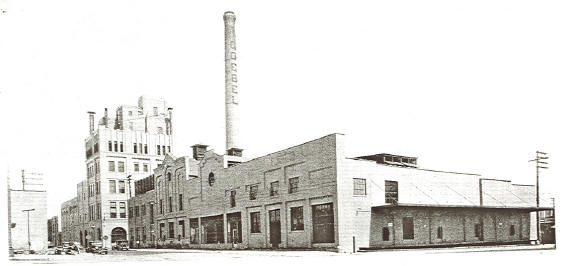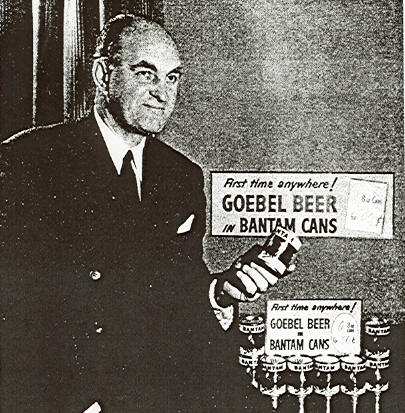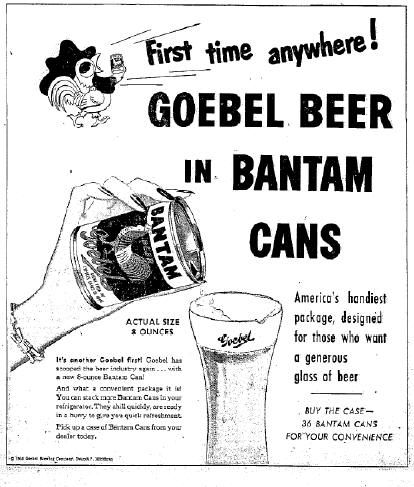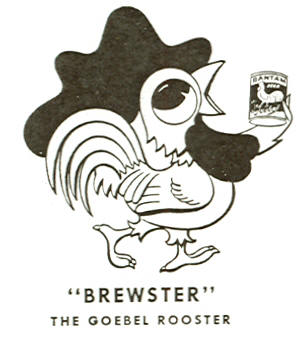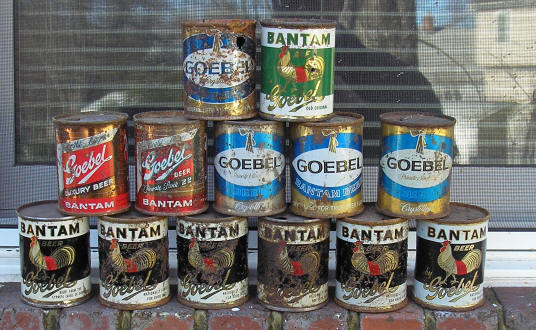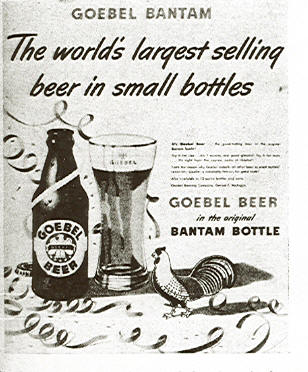Goebel Bantam: Circa 1950
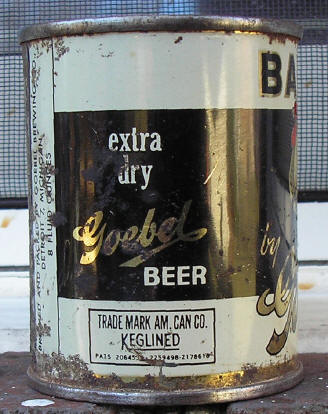 |
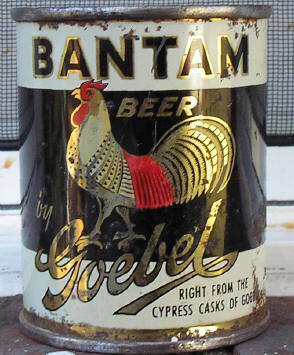 |
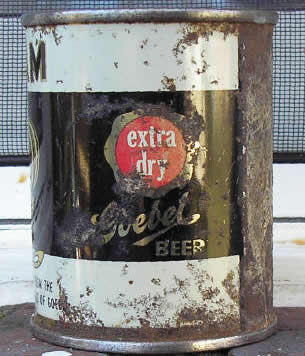 |
I always thought this was a cool can. When I was a teen collecting in the 1970s I called this the "chicken can" and was thrilled when an old time collector sent me one for free as a gift to a young collector. (I wish today I could remember who it was, I'd thank him). That free can was on my shelf for years until I reluctantly upgraded it. So here it is. It's not a rare can but I like the design and Goebel was a leader in marketing 8 oz cans. This is the first of the many different Bantam cans Goebel issued.
Goebel Brewing and the 8 oz can.
I'm going to skip the usual history of the brewery from the beginning. Goebel Brewing, was however, a very successful brewery after Prohibition. They expanded production and in 1946 they purchased the Grand Rapids Brewing Company in Muskegon and operated it from 1946-1957. In 1947 they purchased the Koppitz-Melchers in Detroit and Goebel operated it from 1947-1958. They expanded west in 1950, purchasing the Golden West Brewery which they ran from 1950 until 1955. Their attempt to become a national brand failed, however, and in 1964 they were purchased by Stroh's in Detroit.
Goebel Brewing, the original plant in Detroit. Circa 1937.
In 1950, when the Bantam can was introduced, Goebel was at its height. They had three Michigan breweries and were expanding into California. In 1950 they bought the Golden West Brewery in Oakland. Like other brewers from the east and the midwest, Goebel was not able to crack the west coast market. They did do a good business selling beer to the military for troops in Korea, but when the Korean War ended that market dried up. The Oakland plant was closed in 1956.
While California never worked out as a market, the 8 oz cans were successful. Goebel had successfully introduced their "Bantam" 7 oz bottle in 1938 and it remained a part of Goebel's business into the 1950s. Small 8 oz cans must have seemed like a logical extension of their business after World War II, with the growing popularity of cans. They were, however, the first brewery by only weeks to issue them. In mid 1950 Pittsburgh Brewing introduced their Tech Beer in 8 oz cans as well.
Goebel President Edwin Anderson, holds one of the new 8 oz Goebel cans in a 1950 publicity photo.
The 8 oz can also fit the brewer's marketing strategy of selling beer to women. Starting in the 1930s beer ads for some brands emphasized that beer was "non fattening." After World War II as small grocery stores began to give way to "supermarkets" the brewing trade press was filled with articles about how to increase sales of beer as a grocery item, and especially how to get housewives doing the weekly family shopping trip to buy beer. Beer cans became more colorful, and ads increasingly began to emphasize serving beers with meals. Package sizes also changed. If you look at photos of groceries in the 1930s and 1940s it's common to see beer being sold by the individual can, just like other canned products such as peas or spaghetti sauce. Different package sizes with different numbers of cans were tried to make it easier for women to pick up beer in the store. According to legend, the six pack became popular because it was judged to be the largest package of beer that could be easily picked up by an adult woman with one hand. Of course, all these things were tried as early as the 1930s, but they became much more pronounced after the war.
One of the first Goebel "Bantam" ads.
The 8 oz ounce can fit into this strategy. The ads announcing the new size cans featured a woman's hand holding the can. The hand was not only that of a woman, but of a lady, elegant and tapered, with long well-manicured nails. This was not the hand of a bar maid at a questionable saloon of the pre-prohibition era, but that of a woman who was at least firmly in the middle class. The 8 oz can, marketed as providing a "generous glass of beer" represented both leisure and moderation, perfect for a housewife of a successful middle class man to serve when he returned home from work. Some Goebel Bantam ads even included recipes.
(This did not mean that Goebel ignored the male customer. One story, possibly an urban legend, held that the Bantam cans were popular because a six pack fit perfectly in the metal lunch boxes favored by assembly line workers in Detroit at the time.)
Brewster
The label on the can featured the Bantam symbol, a rooster nicknamed "Brewster." Brewster appeared in newspaper and TV advertisements. Starting in 1952 he was the star in a long series of popular television ads featuring stop action animation using puppets. Transfilm, a stop action movie studio in the Netherlands, made the ads using a technique developed by Transfilm's creative director Joop Geesink. The film studio was known as "Dollywood" and Brewster was redesigned as a doll about 8 inches tall.
Brewster, circa 1950.
The ads showed Brewster in a variety of adventures and in different historical setting: he went to Mars, met the Pilgrims, was a cowboy (Hop-a-long Brewster), sought pirate treasure, etc. They were so well-received that television stations in the Great Lakes states and California, where Goebel was most heavily marketed, received requests to replay the ads. In 1954 the campaign received the Sylvania Television Award for their ingenuity. Goebel continued this campaign until late 1955 or early 1956.
(If you search Youtube for "Joop Geesink" you'll find a few of his other ads from the time. FYI: if anyone who reads this has some better stills, or best yet, an actual copy of one of Joop Geesink's Goebel ads that I can post here or link to, please Contact Me )
Brewster on Treasure Island. I apologize for the poor quality of the image.
The Bantam can went out of favor in the early 1960s and Goebel stopped using them about 1962-1963. Goebel sales as a whole were dropping as well. A Detroit brewery workers' strike in 1958 had lasted for over 6 weeks. As a result, the proportion of out-of-state beer sold in Michigan rose from 33% to 42%. The Detroit brewers were not able to make up the difference after the strike. By 1960 Goebel was only selling 300,000 barrels a year, a far cry from its peak of 1,300,000 barrels in 1953. Sales dropped even further, bottoming out at 216,000 barrels in 1963, the lowest sales total since 1934. In 1964 Goebel was sold to local rival Stroh's and the Bantam was gone. Stroh's later marketed the Goebel brand as a low price beer.
Ironically, the 8 oz can remained in use, but it became associated with Malt Liquor, which was known for its higher alcohol content and with a correspondingly greater kick. Goetz Brewing in Missouri had become successful selling 7 and 8 oz Malt Liquor (and Malt Lager, which is the same thing) cans and in 1962 they were joined by then brewing giant Schlitz, which introduced Schlitz Malt Liquor with its now familiar bull on the label in small cans. The 8 oz can started off being marketed for women, but became a success selling a product geared towards a male market that wanted more alcohol for the dollar.
Here are all the 8 oz Goebels in my collection. I still have quite a few left to get. These are all from Michigan. Yes, they are all different. According to Michigan can specialists there are 20 different total.
A Goebel Bantam bottle ad, circa 1939.
Sources Used
Blum, Peter H. Brewed in Detroit (Wayne State University Press, 1999)
"Brewster Goes to Bat for Goebel" Brewer's Journal. (March 1955)
"Goebel of Detroit Introduces 'Bantam' Bottle" Brewer's Journal. (November 1938)
"Is This the Perfect Brewery?" Modern Brewery. (January 1935)
"Now It's 8-oz cans" Modern Brewery Age. (July 1950) 48.
Peterson, Dave and Bob Venners. "The Bantam Story" BCCA News Report. (May/June 1981)
"Something Really New in Beer Packaging" (advertisement) Beer Distributor. (August 1950)
Taylor, Chris. "Michigan Variations: Crystilled Goebel Bantams" Rustlings. (February 1998)
A big thanks to Chris T and to Randy K. for all their help.

